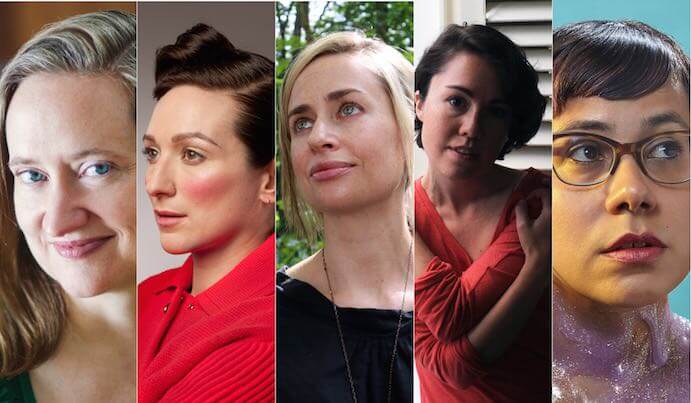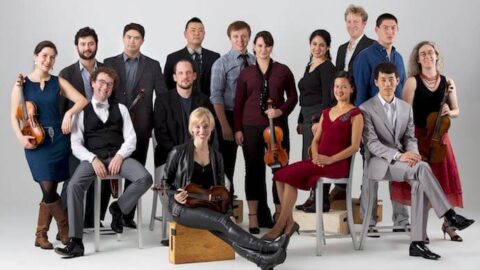The Boston-based orchestra A Far Cry and Grammy award winning singer Luciana Souza brought their latest collaborative masterpiece The Blue Hour to New England Conservatory’s Jordan Hall on November 10, 2017. Jointly composed by Rachel Grimes, Sarah Kirkland Snider, Angélica Negrón, Shara Nova, and Caroline Shaw, The Blue Hour is an evening-length song cycle for voice and orchestra that sets the poem “On Earth” from Carolyn Forché’s 2003 collection Blue Hour. Forché’s text takes the form of an abedecary (an alphabetical listing of images) and explores the fleeting thoughts of the last hour of a person’s life.
Needless to say, this is a star-studded project. However, as a woman at the helm of one of the largest online communities for new music, I did not anticipate that celebrating the achievements of fellow women in new music would require me to consider my word choice so carefully. In the wake of projects like Listening to Ladies and #HearAllComposers, it is easy to get caught up in singing the praises of anyone who is not a cisgendered straight white man—especially those whose visibility and success are challenging imbalanced concert programming and providing positive mentorship for the next generation of composers.
Yet enthusiastic recognition of these artists without a substantive discussion about their work implies that minority, LGBTQ, and women composers should merely be congratulated for succeeding in spite of their race or gender, with little to no regard for the quality of their output. How, then, do we celebrate projects prominently featuring artists that defy historical marginalization without reducing them to a gender/race-first-composer-second narrative?

In an interview with I CARE IF YOU LISTEN prior to the November 4th premiere of The Blue Hour in Washington, D.C., Negrón astutely noted, “Given the disproportionate representation and inclusion of women in the composition world, this project naturally stands out first as a one by a group of female composers. It’s sensitive and less than ideal for me to define this project by our gender, but I also recognize the need to underline and make clearly visible what is often invisible and silenced.”
While it is still important to recognize that this project prominently features creative voices that have been traditionally underrepresented, The Blue Hour is less about the fact that the five composers are women and more about the shared aesthetic of the five composers—which is emotionally direct, unapologetically lyrical, luminously consonant, and melodically expressive. Snider has previously commented on the challenges of staying true to this aesthetic in new music’s dichotomy of “serious/cerebral/systems-based/complex/masculine vs. less serious/emotional/intuitive/simple/feminine.” However, the sincere, genuine expressivity of the music is precisely the thing that makes The Blue Hour so successful—it serves the text above all else and creates a lush sonic landscape that is reflective of the poetry.
Due to the structure of the poetry and the division of compositional duties among the five composers, the text and the music of The Blue Hour do not have a clear overarching narrative. One could criticize the homogeneity of the music for its lack of development, but the unconventional structure of the text lends itself to a score that does not have a comprehensive formal organization. This absence of familiar structural elements in both the poetry and the music removes the listener’s ability to anticipate, and ultimately, the listener must succumb to the narrator’s scattered memories, which results in a beautiful, complex, empathetic journey over the course of the work.

Though grounded in a shared aesthetic, plenty of moments from the individual composers stand out. Grimes’ “the name” is blissfully tender with resonant string writing, and Snider’s “each a ring of soot” is a bright, irregular-metered hocket. Nova’s “library, lilac” features a loose recitative style text delivery over a driving bass line, and “nevertheless” put the warm, sonorous tone of viola soloist Jason Fisher on full display. The ensemble establishes a lilting mixed meter groove by Negrón, chanting “canticle, casement, cask, cerement, cinder,” and later, Negrón weaves together a delicate ricochet bowing echo effect on a single pitch in “her hair.” In “firament,” Shaw juxtaposes the rhythmic drive of Baroque music and minimalism using quotations from the second Brandenburg Concerto and invokes monophonic chant at the mention of a Kyrie. The stunning conclusion of the work plunges the audience into a deep blue light for Shaw’s haunting canon “all of this must remain.”
The Blue Hour is a remarkable achievement by five of today’s leading composers–not women composers, just composers–and an outstanding group of performers. Throughout, the self-led A Far Cry performed with the precision and interconnectedness of chamber music while never overpowering the soloist. Luciana Souza’s instrumental-like command of timbre and minimal use of vibrato made for an impressive and intimate performance. The final result of these disparate parts coming together is an incredibly moving work that certainly accomplishes the intent of the project: to elicit empathy and provide “a lens through which to see our own world with greater clarity.”
























